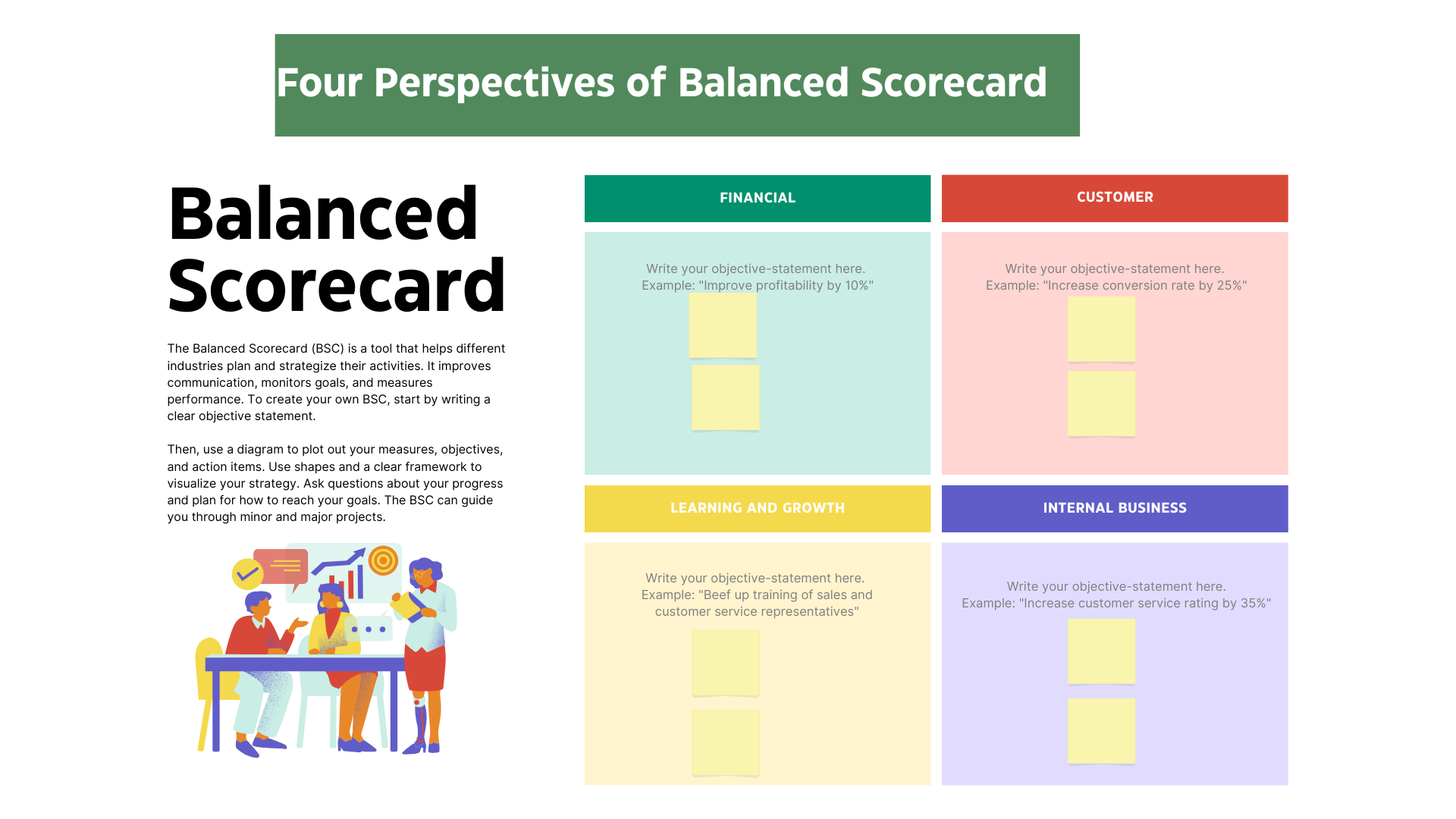In today’s dynamic business environment, organizations face the challenge of not only formulating effective strategies but also executing them successfully. The Balanced Scorecard (BSC) offers a robust framework that helps companies align their activities with their vision and strategy, ensuring that strategic goals are translated into operational terms.
Introduction to the Balanced Scorecard
The Balanced Scorecard, introduced by Robert Kaplan and David Norton in the early 1990s, revolutionized performance measurement by integrating financial and non-financial metrics. The BSC focuses on four key perspectives:
- Financial Perspective: Evaluates the financial performance and the economic consequences of actions taken.
- Customer Perspective: Measures the company's success in its target market and the satisfaction level of its customers.
- Internal Business Processes Perspective: Analyzes the efficiency and effectiveness of critical business processes.
- Learning and Growth Perspective: Assesses the organization's capacity to innovate, improve, and learn, thereby sustaining long-term growth.

Translating Strategy into Objectives
The foundation of effective strategic execution lies in clearly defined objectives. These objectives should be derived from the organization’s vision and strategy and then categorized into the four perspectives of the Balanced Scorecard.
Example: Eco-Friendly Packaging Company
For a company striving to become a market leader in eco-friendly packaging solutions, the strategic objectives might include:
- Financial Perspective: Increase annual revenue by 15%.
- Customer Perspective: Improve customer satisfaction score by 10%.
- Internal Processes Perspective: Reduce production waste by 20%.
- Learning and Growth Perspective: Increase employee training hours by 30%.
These objectives ensure that all parts of the organization are working towards common goals.
Developing Metrics and KPIs
Key Performance Indicators (KPIs) are crucial for measuring progress toward strategic objectives. Each objective should have specific, measurable KPIs that provide clear targets for the organization to aim for.
Example KPIs for the Eco-Friendly Packaging Company:
- Financial KPIs: Quarterly revenue growth, profit margins, cost reductions.
- Customer KPIs: Customer satisfaction scores, net promoter score (NPS), customer retention rates.
- Internal Processes KPIs: Waste reduction metrics, production efficiency, cycle times.
- Learning and Growth KPIs: Training completion rates, employee satisfaction surveys, innovation metrics.
Regular monitoring of these KPIs enables organisations to track their progress and make necessary adjustments.
Aligning Initiatives and Projects
To achieve strategic objectives, it’s essential to align all initiatives and projects with the Balanced Scorecard. Every initiative should support one or more strategic objectives, and resources should be allocated based on their strategic importance.
Example Initiatives:
- Financial: Launch a cost-reduction program to enhance profitability.
- Customer: Develop a customer feedback system to gather and act on customer insights.
- Internal Processes: Invest in recycling technology to reduce production waste.
- Learning and Growth: Implement comprehensive training programs on sustainability practices.
Aligning initiatives with the BSC ensures that every project contributes to the strategic goals.
Communicating and Cascading Objectives
Effective communication is crucial for successful strategic execution. The Balanced Scorecard helps cascade objectives from the top level to individual departments and employees, ensuring that everyone understands their role in achieving strategic goals.
Steps for Cascading Objectives:
- Develop Departmental Scorecards: Break down the organizational BSC into departmental scorecards that reflect each department’s role in the strategy.
- Set Individual Goals: Align individual employee goals with departmental and organizational objectives.
- Regular Updates and Meetings: Hold regular meetings to discuss progress, address challenges, and ensure alignment.
By cascading objectives, organisations create a cohesive environment where all employees are focused on common goals.
Monitoring and Evaluating Performance
Regular performance reviews are essential for evaluating the effectiveness of strategic execution. Organizations should establish a routine for reviewing KPIs, assessing progress, and making necessary adjustments.
Performance Review Process:
- Monthly or Quarterly Reviews: Schedule regular reviews to evaluate performance against the BSC.
- Data Analysis: Analyze performance data to identify trends, successes, and areas for improvement.
- Adjust Strategies: Make necessary adjustments to strategies and initiatives based on performance data and changing business conditions.
This continuous evaluation process ensures that the organization remains on track to achieve its strategic objectives.
Continuous Improvement and Feedback
The Balanced Scorecard fosters a culture of continuous improvement by regularly collecting and analyzing data. This process helps organizations identify areas for improvement and innovate to stay competitive.
Feedback Loop:
- Collect Data: Gather performance data from various sources, including KPIs and employee feedback.
- Analyze Data: Use the data to identify strengths and weaknesses in the strategy and execution.
- Implement Improvements: Make changes based on the analysis to improve processes, strategies, and performance.
For example, if employee training programs are not yielding the expected results, the company might seek feedback from participants and adjust the training content or delivery methods.
Integrating with Other Management Processes
To maximize the effectiveness of the Balanced Scorecard, it should be integrated with other key management processes such as budgeting, performance management, and risk management.
Integration Steps:
- Link to Budgeting: Align the budgeting process with the BSC to ensure resources are allocated to strategic priorities.
- Performance Management: Incorporate BSC metrics into employee performance appraisals to reinforce strategic alignment.
- Risk Management: Use the BSC to identify and manage risks that could impact strategic objectives.
By integrating the BSC with these processes, organizations can create a comprehensive system for managing strategy execution.
Conclusion
Measuring success in strategic execution using the Balanced Scorecard provides a structured and comprehensive approach to translating strategy into action. By focusing on financial, customer, internal processes, and learning and growth perspectives, organizations can ensure a balanced view of performance. Regular monitoring, communication, and continuous improvement are key to achieving and sustaining strategic goals. The Balanced Scorecard not only helps in measuring success but also drives the entire organization towards a common vision and strategic objectives.